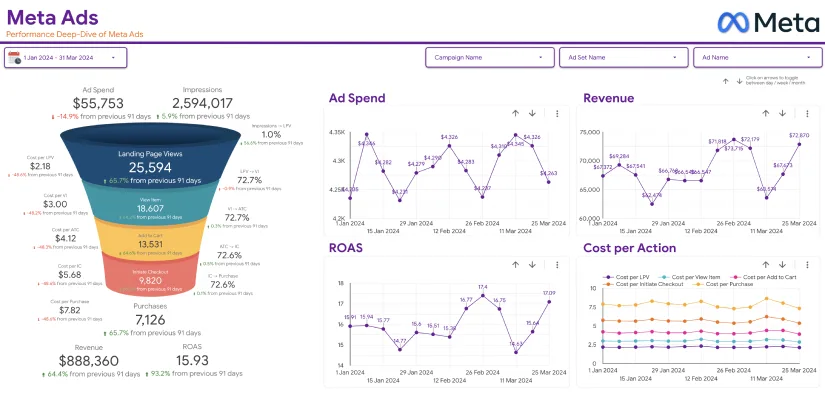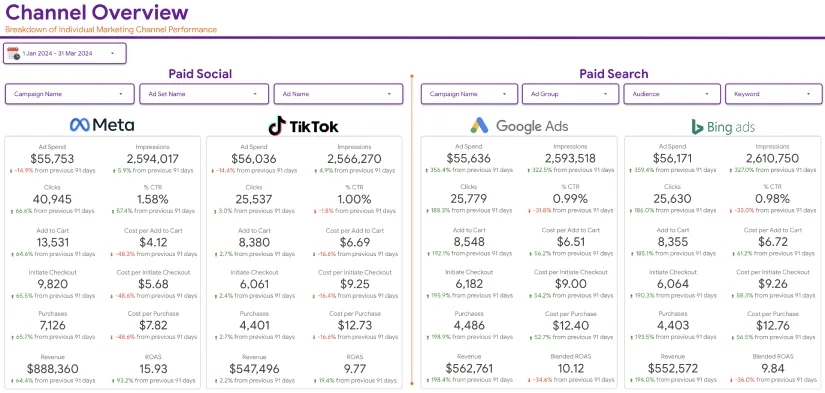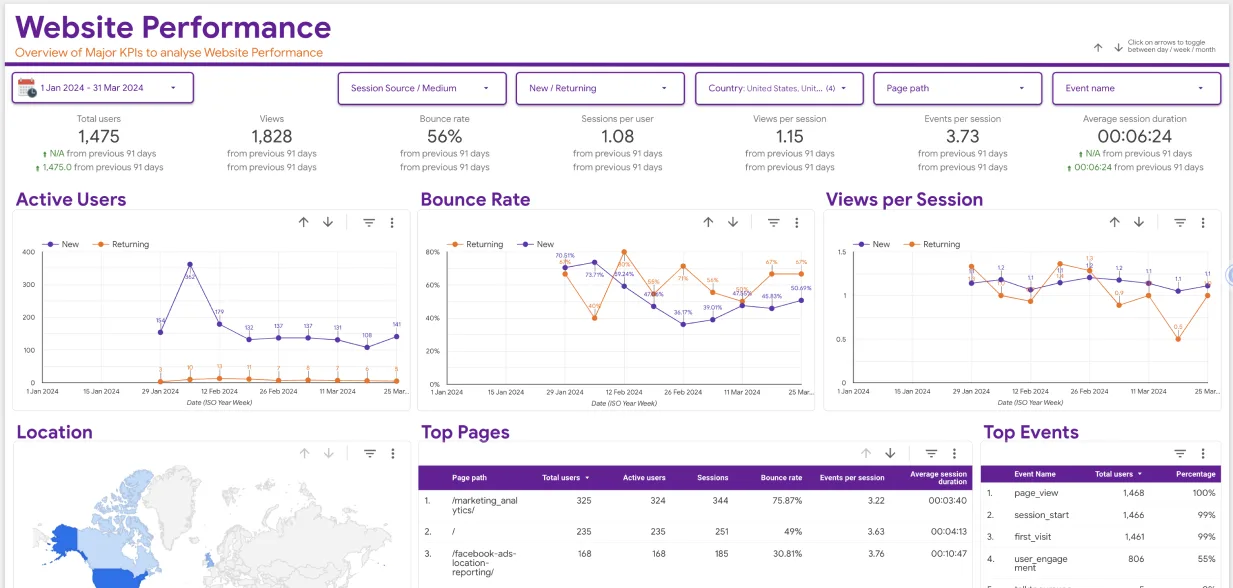When it comes to the issue of site traffic, it’s important that you know how to identify bot traffic in Google Analytics because not every traffic is from human visitors. Bot traffic can send any marketer into a tailspin because it denies them the chance to make conversions.
In an ideal marketing world, every visitor to your website is likely to make a purchase when they browse and interact with your website content. But you wouldn’t say the same for bot traffic. Even though some bots are good, others are downright bad for your business.
Last year, we saw Elon Musk declaring a crackdown on bots, claiming they spammed users on X (formerly Twitter) a lot, and this made the platform lose its grip. So, in short, getting too much traffic from bots on your website will make it harder to know if your campaign is performing as it should or not.
Thankfully, if you’re already using Google Analytics, it’s not that difficult to spot bot traffic, but it’s not that straightforward. In this post, we’ll dig deep into how to identify bot traffic in Google Analytics, why it’s important, and what you can do about it.
What Is Bot Traffic?
Bot traffic is visits to your website from automated scripts rather than real human visitors. Now, one thing you should not is that not all bots are malicious—think of Googlebot, which is Google’s search engine crawler that helps in indexing websites. Then there are the dark ones, built to inflate traffic numbers, skew your analytics data, and sometimes even carry out fraudulent activities like ad click fraud.
The dark bots can make a marketer’s life difficult by messing up their conversion rates, creating inaccurate traffic figures, and wasting ad spend. That’s why you need to stay on top of your game when it comes to spotting and filtering out bot traffic.

Don’t think that it’s got something to do with the security of your website, no not at all. In fact, about 40% of all internet traffic comes from bots. It’s usually something very difficult to avoid. The best you can do is keep up with identifying and filtering them out so all your website data analytics are authentic.
Steps on How to Identify Bot Traffic in Google Analytics
Google Analytics doesn’t give you a direct way to identify bot traffic but there are tell-tale signs you need to look out for to know which traffic is bot-generated. Let’s address each of these signs.
Step 1: Analyze Unusually High Traffic Spikes
The first and most obvious way to identify bot traffic is when you suddenly receive an unexplained spike in your website traffic. Of course, everyone gets a little excited with a good traffic boost. But if you haven’t launched a new campaign, had some celeb endorsement, or released a trendy product, then that sharp increase could be a red flag.
The thing with bot traffic is that it usually surges pretty fast and the visits they bring have nothing that resembles human visits. These visits often bounce immediately without spending significant time on your site. If you’ve noticed something out of the ordinary in your web traffic, don’t just brush it off. Investigate deeper by looking at the data.
How to Spot Bot Traffic
- Sign into your Google Analytics and go to AudienceàOverview.
- Check whether there are any significant traffic jumps without an explanation.
- Go to BehavioràSite ContentàAll Pages and review any page that has suspiciously high hits without a marketing explanation.
Step 2: Review Bounce Rate and Session Duration
Bot traffic often comes with behavioral patterns that can help identify other misalignments. For instance, a low session duration coupled with high bounce rates is a good indicator of bot activity. A real user tends to explore a couple of pages, click links, and spend some time on the website. Bots, however, will likely visit a single page and then leave a few seconds later.
How to Review Bounce Rate and Session Duration

- Go to AudienceàOverview.
- Check the Bounce Rate and Average Session Duration. If you notice a sharp increase in bounce rate or a sudden drop in session duration, you’re likely looking at bot activity.
- To get a deeper view, go to Behaviorà Site ContentàLanding Pages to identify which pages received high bounce traffic.
Step 3: Analyze Geographic Location
When you closely inspect traffic from real human visitors, you’ll see that the operating system they’re using and their location are often specified. But for bot traffic, location is often not set and you’ll be able to see this in your Google Analytics dashboard. If you suddenly receive high traffic and you suspect its bot-generated, check out the geo-location.
At times, the traffic may come from other countries. For instance, if your business only serves the UK, and you suddenly receive high traffic from other countries that are not targeted in your marketing campaigns, that might be an indicator that you’re dealing with bots.
How to Spot Bot Traffic Based on Geolocation
When it comes to how to identify bot traffic in Google Analytics based on their geolocation, follow these steps:
- Go to AudienceàGeoàLocation and check the source of your traffic. If there’s a surge from a country or city outside your target audience, dig deeper.
- You can also use Secondary Dimension: Network Domain to identify whether traffic from those regions is from suspicious organizations or ISPs.
Step 4: Check Your Referral Traffic
It can feel good to get new referral traffic. Unfortunately, the traffic could be from irrelevant or shady sites and that can end up costing your website’s authenticity. If you’ve noticed a lot of referral traffic from sites not aligned with your niche, it’s likely bot traffic.
Such traffic will only inflate your numbers without the “visitors” converting into leads or customers. What a waste of your ad spend! Such referrer spam bots are very common in Google Analytics data and can end up misleading you that you’re doing great when you don’t.
How to Spot Bot Referral Traffic
- Go to AcquisitionàAll TrafficàReferrals to view the sources of your referral traffic.
- Inspect for traffic from sites you don’t recognize or spammy domains.
- Verify whether the visits are actually headed to your site using Secondary Dimension: Hostname.
Step 5: Monitor Engagement Metrics on Key Pages

Another method how to identify bot traffic in Google Analytics involves assessing your engagement metrics, especially on pages that need more user interaction, such as product pages or blog posts.
You’d expect a real human user to engage with your content by scrolling, clicking on CTAs, commenting, or even watching a video. But with bots, not so much. All they do is hit the page and then bounce. If you notice engagement rates dropping on content-rich pages, bots could be the culprits.
Hot To Identify Bot Traffic from Engagement Metrics
- Go to BehavioràSite ContentàAll Pages and assess the high-value content pages.
- Check the Bounce Rate, Time on Page, and Exit Rate. Carry out further investigation if you notice a sudden drop in engagement in the pages.
Step 6: Use Google’s Built-in Bot Filtering
If you didn’t know, Google Analytics offers a built-in feature for filtering commonly known bots from your campaign data. Although the feature doesn’t filter everything, it’s a good starting point if you want to reduce the impact bots have on your marketing efforts.
How To Spot Bots Using Built-in Filter
- Sign into your Google Analytics account and go to AdminàView Settings.
- Scroll down the page then check the “Exclude all hits from known bots and spiders” box.
More sophisticated bots will likely escape this filter, but it can be a good start to cleaning your data.
Step 7: Create a Custom Segment to Isolate Suspected Bot Traffic
Looking for how to identify bot traffic in Google Analytics the easy way? Creating a custom segment in Google Analytics is one of the easiest ways to filter out stubborn bots. This tactic lets you isolate any traffic from suspicious sources so you can focus your efforts on analyzing real human visitors.
How to Create a Custom Segment in Google Analytics
- Go to AudienceàOverview and click on Add Segment, followed by +New Segment.
- Specify the conditions based on abnormal behavior, such as high bounce rate, low session duration, or traffic from strange locations.
- Apply this custom segment to your reports and start filtering out any activity suspected to be from bots.
Why Is It Important to Identify Bots
Learning how to identify bot traffic in Google Analytics is important. But what does it mean to your analytics data and overall marketing campaign?
Get Accurate Data
Relying on skewed data generated by bots will without a doubt affect your decisions. Imagine what it would cost you to optimize your campaign based on engagement metrics created by bots. This will only lead to a wastage of your resources and time as there won’t be any conversions made.
Better ROI

When bots click on paid ads you’ve invested a lot of money in, they’re only wasting your budget since there will be no conversions from those fake clicks. Filtering them out ensures your ad spend reaches real users who can potentially convert.
Campaign Performance
It’s easier to work with clean data because you can accurately gauge your campaign performance and make adjustments as needed.
Conclusion: Get Smart About Bot Traffic
With the digital market changing rapidly, it pays to work with clean data because it’s your secret weapon. That calls for you to know how to identify bot traffic in Google Analytics and filter them out so you can be sure the insights you’re using are real.
If doing all this to remove bots from your website analytics sounds too complex, perhaps seeking assistance from professionals can be a good move for you. Eaglytics Co can help you through Google Analytics dashboards to manage bot traffic and improve the accuracy of your data analytics. Our data-driven marketing solutions empower businesses to enhance their performance using clean, actionable insights. Get in touch today to get started.





